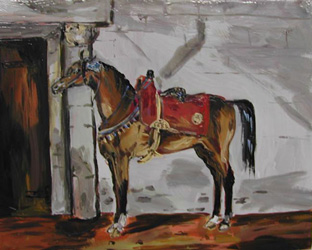Karen Kilimnik, Ruffian, an Arabian horse at the side street near the bazaar, Marrakesh, 2006.
Born 1957 in Philadelphia, Pennsylvania; lives in Philadelphia, Pennsylvania
Best known for the deconstructed, so-dubbed “Scatter” installations she pioneered in the late 1980s, Karen Kilimnik has more recently alighted on painting-based mise-en-scènes replete with diminutive, loosely rendered canvases and related props. In The Debonair General’s Tent (2006), a Napoleonic campaign tent furnished with a desk, maps, and a phalanx of toy soldiers is positioned alongside a suite of Théodore Géricault–inspired paintings. Like her earlier work, Kilimnik’s new projects evidence a lush, quasi-fictive world where august artistic references (e.g., Jean-Baptiste Oudry, George Stubbs, and Sir Henry Raeburn) brush shoulders with contemporary news and cultural icons including Keith Richards, Kate Moss, and Leonardo DiCaprio (especially memorable as Kilimnik’s louche Prince Charming [1998]).
Fog machines and minutely chosen decor and furniture likewise abet a through-the-looking-glass experience where, moored in the particularities of specific contexts, nothing is what it seems. As Kilimnik states: “Being so inspired by fairy tales, mysteries, books, TV shows, and ballets, et cetera, I like to make up characters myself as if I’m a playwright.” Her mode of appropriation thus involves possession as much as fantasy. Mediation predicated on distance is explicit in The Hellfire Club Episode of the Avengers (1989), which pays homage to an infamous 1966 episode ( banned by U.S. censors) of the British spy show with an installation of black-and-white photocopies, photographs, and a soundtrack sampling harpsichord music, the Avengers theme, Madonna, and the Pet Shop Boys.
As seen in the recent work shown in her 2007 survey at the Institute of Contemporary Art in Philadelphia, Kilimnik’s period sensibilities have become even more striking. the bluebird in the folly (2006) is a coyly graceful garden pavilion seemingly plucked from Marie Antoinette’s Versailles—except that it harbors a video of Thumbelina-like ballerinas alighting on trees amid verdant woodland scenery. Such eighteenth-century fantasies of escapism played out by aristocrats on palace grounds give way to an investigation of eighteenthcentury salon display strategies in The Red Room (2007): inside a nondescript, freestanding white cube placed in a corner of the gallery is a richly appointed red brocade chamber on whose walls fifty of the artist’s paintings hang cheek by jowl. In this matryoshka-like exhibition within an exhibition, Kilimnik makes explicit her operative use of the gallery as a frame— and as an ersatz if dream factory–worthy facade. SUZANNE HUDSON
Karen Kilimnik, Ruffian, an Arabian horse at the side street near the bazaar, Marrakesh, 2006. Water-soluble oil on canvas, 8 x 10 in. (20.3 x 25.4 cm). Collection of Charlotte and Bill Ford.
























